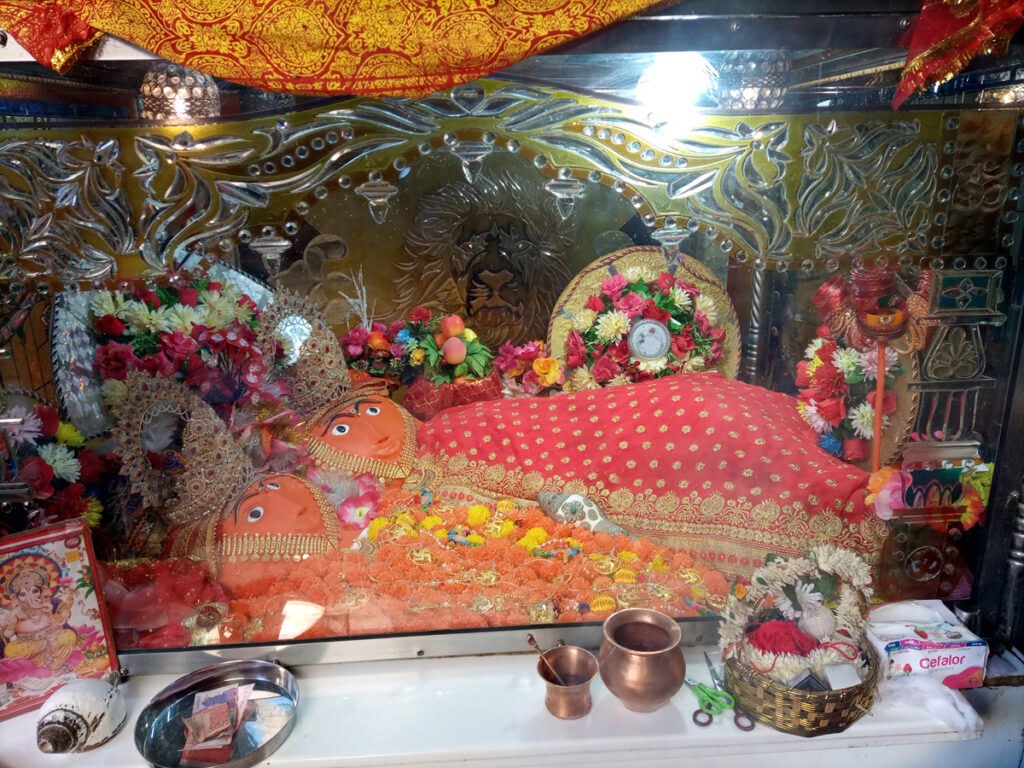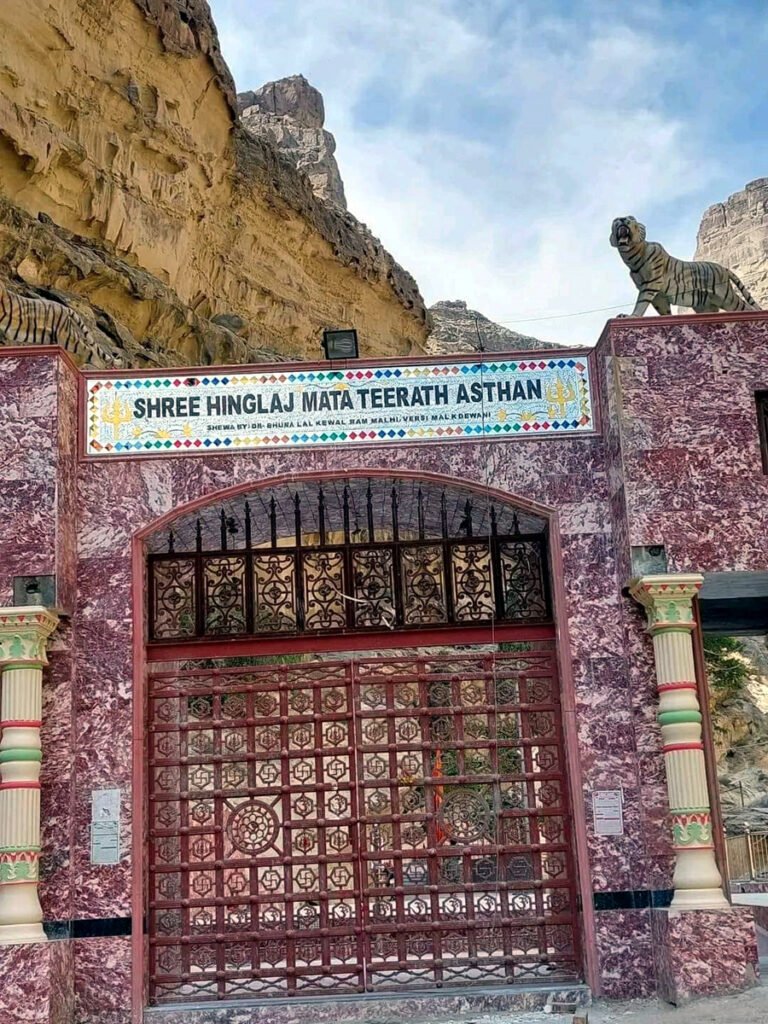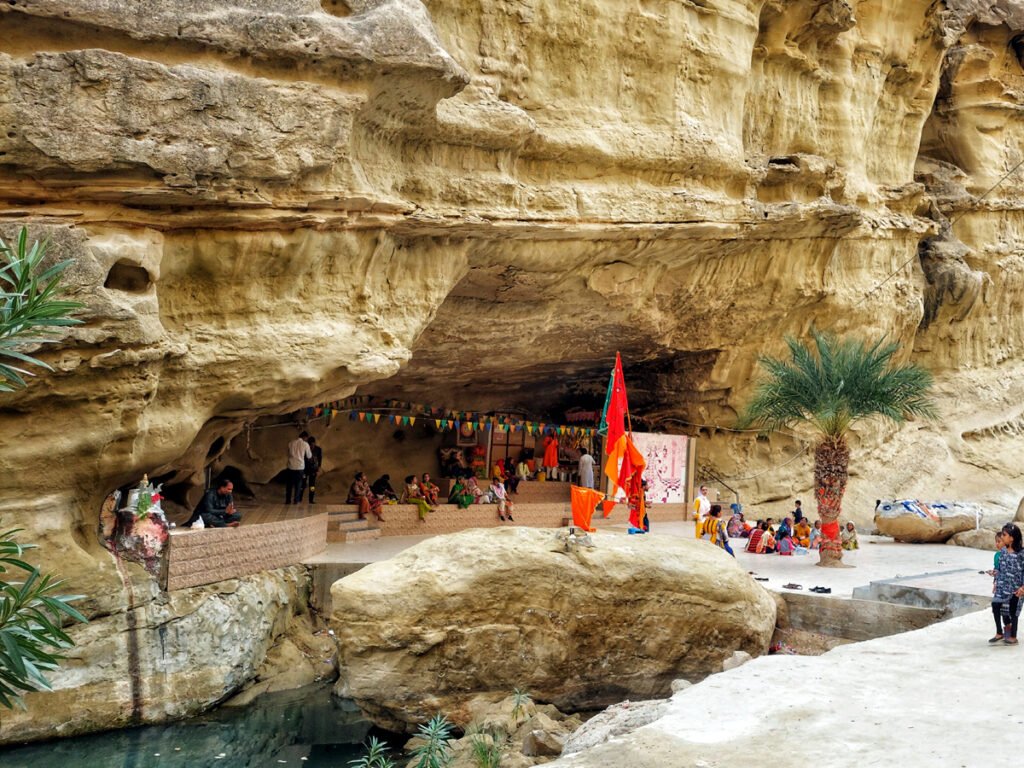Hinglaj Mata Temple Balochistan
Hinglaj Mata temple or Nani Mandir is one of the Shakti Peeth located in a remote hilly area of Lyari Tehsil, Balochistan, Pakistan. Hinglaj temple is on the mountain named Hinglaj on the river bank of Hinghol.

Contents
- 1 Significance:
- 2 History:
- 3 Places to visit near Hinglaj Devi Temple:
- 4 FAQ:
- 4.0.1 What is Hinglaj Mata Temple?
- 4.0.2 When is the best time to visit Hinglaj Devi Temple?
- 4.0.3 What is the history of Hinglaj Mata Temple?
- 4.0.4 What is the significance of Hinglaj Mata Temple?
- 4.0.5 What are the festivals celebrated at Hinglaj Mata Temple?
- 4.0.6 How to reach Hinglaj Mata Temple?
- 4.0.7 What are the rules and regulations at Hinglaj Mata Temple?
- 4.0.8 Where is Hinglaj Devi Temple located?
- 5 How to reach Hinglaj Mata Temple in Pakistan from India:
- 6 How to reach Hinglaj Mata Temple from other places:
- 7 Google Maps:
Significance:
According to the mythology Daksha yagna and Sati self-immolation, it is the holy place where “Bramharandra (part of the head)” fell down.
From our ancient scripts and local people, we get to know that Hinglaj Mata is a powerful deity form of Durga who blesses her devotees and fulfills their wishes. The presence of Goddess Hinglaj is been stated in many ancient scripts like Kularnava Tantra, Kubjika Tantra, Tantrachudamani, and Shivasharitha. Locally devi is called by different names like Kottari, Kottarisha Kottavi, etc., and the Bhairava form of Lord Shiva associated with a goddess is called with the name Bhimalochan.
We find Hinglaj Devi is made with shapeless stone smeared with Sindhoor. Local Muslims provide security to the temple and call the deity with the name Nani Mandir.
Every year during the month of April we find a four-day annual ceremony. Among the four-day ceremony, the third day is celebrated with great devotion, on this day temple priest chants mantras and invokes gods to accept the offering (3 coconuts) bought by their devotees. Devotees from local and neighboring countries come here to worship. Devotees take all kinds of transport systems like buses, private vehicles, and even bicycles. Few devotees say that the more austerities we face, the more is the grace of the goddess.
Read More>> Virat Shakti Peeth | Ambika Shaktipeeth.
History:
According to Hindu mythology, Sati, the wife of the god Shiva, immolated herself in a fire after her father Daksha insulted Shiva. Shiva was enraged by Sati’s death and carried her body around the world in his grief. Vishnu, another Hindu god, used his discus to cut Sati’s body into pieces, which fell to earth and became Shakti Peethas.
The Hinglaj Devi Temple is believed to be the place where Sati’s forehead fell. The temple is located in a remote and mountainous region, and it is said that the journey to the temple is as important as the pilgrimage itself.
The history of the Hinglaj Devi Temple is long and complex. The temple is mentioned in several ancient Hindu texts, including the Puranas and the Mahabharata. The earliest known reference to the temple is in the Varaha Purana, which is estimated to be over 2,000 years old.
The temple has been destroyed and rebuilt several times over the centuries. The current temple is believed to have been built in the 16th century.
The Hinglaj Devi Temple is a popular pilgrimage site for Hindus from all over the world. The temple is especially crowded during the annual Hinglaj Mela, which is held in April. The Mela is a three-day festival that attracts hundreds of thousands of devotees.
The Hinglaj Devi Temple is also a significant religious site for Muslims in Pakistan. Many Muslims visit the temple to pay their respects to Bibi Nani, as they call the goddess.
The Hinglaj Devi Temple is a unique and fascinating place. It is a testament to the rich and diverse religious heritage of Pakistan.
Read More>> Nandikeshwari Temple | Nandipur Shakti Peeth, Sainthia

Places to visit near Hinglaj Devi Temple:
Hingol National Park: This is the largest national park in Pakistan, and it surrounds the Hinglaj Devi Temple. The park is known for its diverse wildlife, including the Persian leopard, as well as its stunning landscapes, such as the Princess of Hope rock formation.
Kund Malir Beach: Located along the Makran Coastal Highway, Kund Malir Beach is known for its serene beauty. It’s an excellent place to relax, swim, or take a stroll along the shoreline. The drive to the beach offers breathtaking views of the Arabian Sea and the surrounding hills.
Ormara Beach: Another beautiful beach near Hinglaj, Ormara Beach is known for its calm waters and picturesque surroundings. It’s a great spot for water activities like swimming and boating.
Bela: This town is famous for its historic fort, the Bela Fort. The fort dates back to the 17th century and is a noteworthy historical attraction.
Kund Malir Desert: In addition to the beach, the Kund Malir area also features a desert landscape with sand dunes. It’s an excellent place for camel rides and experiencing the desert environment.
Gwadar: If you’re looking for a larger urban center, Gwadar is a port city known for its natural beauty. You can explore the Gwadar Port, visit local markets, and enjoy fresh seafood at the local restaurants.
Astola Island (Jezira Haft Talar): Although it’s a bit farther from Hinglaj, Astola Island is a remote and pristine location in the Arabian Sea. It’s known for its unique rock formations, coral reefs, and diverse marine life. However, getting to the island requires careful planning and permission.

FAQ:
What is Hinglaj Mata Temple?
Hinglaj Mata Temple is a Hindu temple located in Hinglaj, a town on the Makran coast in the Lasbela district of Balochistan, Pakistan. It is one of the 51 Shakti Peethas in Shaktism denomination of Hinduism. It is one of the two Shakti Peethas in Pakistan, other being Shivaharkaray. It is a form of Durga or Devi in a mountain cavern on the banks of the Hingol River.
When is the best time to visit Hinglaj Devi Temple?
The temple is most visited during the annual Hinglaj Yatra, which typically takes place during the months of April and May. This is considered the best time to visit if you want to witness the grand festivities and a large gathering of devotees.
What is the history of Hinglaj Mata Temple?
The history of Hinglaj Mata Temple is shrouded in mystery. According to legend, the temple was founded by the sage Kashyapa. It is said that the head of Sati, the wife of Shiva, fell at this site after she was beheaded by her father, Daksha, in a fit of rage.
What is the significance of Hinglaj Mata Temple?
Hinglaj Mata Temple is one of the most important pilgrimage sites for Hindus in Pakistan. It is believed that the goddess Hinglaj Mata is capable of granting wishes and bestowing good fortune on her devotees. The temple is also a popular tourist destination, attracting visitors from all over the world.
What are the festivals celebrated at Hinglaj Mata Temple?
The most important festival celebrated at Hinglaj Mata Temple is the Hinglaj Yatra, which is held every year in April. During this festival, thousands of Hindu devotees from all over Pakistan and India come to the temple to pay their respects to Hinglaj Mata.
How to reach Hinglaj Mata Temple?
Hinglaj Mata Temple is located in the Hingol National Park, which is a remote area of Balochistan. The nearest airport is Karachi, which is about 250 kilometers away. From Karachi, there are bus and taxi services available to Hinglaj.
What are the rules and regulations at Hinglaj Mata Temple?
There are a few rules and regulations that visitors must follow when visiting Hinglaj Mata Temple. These include:
- Women must cover their heads and shoulders.
- Visitors are not allowed to wear footwear inside the temple.
- Visitors are not allowed to take photographs inside the temple.
Where is Hinglaj Devi Temple located?
Hinglaj Devi Temple is situated in Hingol National Park, which is in the Lasbela District of Balochistan, Pakistan.
How to reach Hinglaj Mata Temple in Pakistan from India:
Obtain a Visa:
You will need a Pakistani visa to enter Pakistan. Apply for a tourist visa at the nearest Pakistani embassy or consulate in India. Visa requirements and procedures may change, so check with the relevant authorities for the most up-to-date information.
Travel to the Nearest Border:
Choose a border crossing between India and Pakistan. The most commonly used border crossings for tourists are the Wagah-Attari border (near Amritsar in India) and the Munabao-Khokhrapar border (Rajasthan-Sindh border). Check the latest information on border crossing procedures, as they may change.
Entry into Pakistan:
After crossing the border, you’ll need to go through immigration and customs procedures on the Pakistani side. Make sure you have all the required documents, including your visa and any necessary permits.
Transportation within Pakistan:
Once in Pakistan, you’ll need to arrange transportation to the Hinglaj Mata Temple. The temple is located in Balochistan, so you may need to travel by road. Consider hiring a local guide or driver who is familiar with the area, as it can be challenging to navigate without local knowledge.
Safety Considerations:
Be aware of the security situation in Balochistan and follow any travel advisories issued by your government. It’s essential to prioritize your safety at all times.
Accommodation:
Look for accommodation options in the vicinity of Hinglaj Mata Temple or nearby towns. Balochistan may not have as many tourist facilities as other regions, so plan your stay accordingly.
Temple Visit:
When visiting the Hinglaj Mata Temple, be respectful of local customs and religious practices. Follow any guidelines provided by temple authorities.
Return to India:
After your visit, you’ll need to retrace your steps back to the border and complete the necessary immigration and customs procedures to re-enter India.
How to reach Hinglaj Mata Temple from other places:
From Karachi:
- Take the National Highway N-25 west towards Quetta.
- After approximately 75 miles, turn left onto the road to Hinglaj.
- Follow the road for approximately 175 miles to the temple.
From Quetta:
- Take the National Highway N-25 east towards Karachi.
- After approximately 120 miles, turn right onto the road to Hinglaj.
- Follow the road for approximately 130 miles to the temple.
The road to the temple passes through rugged and mountainous terrain, so it is advisable to hire a local guide or take a local transport service. You can also rent a 4WD vehicle, which is recommended.
The journey from Karachi takes approximately 8-10 hours by road, while from Quetta, it takes around 4-5 hours.
Here are some additional tips for reaching Hinglaj Devi Temple:
- The best time to visit the temple is during the winter months (October to March), when the weather is cooler.
- It is important to dress respectfully when visiting the temple, as it is a holy site for Hindus.
- You will need to obtain a visa to visit Pakistan. You can apply for a visa at the Pakistani embassy or consulate in your home country.
- It is important to check the latest security advisories before traveling to Pakistan.
Please note: The Hinglaj Devi Temple is located in a remote area of Balochistan, which has been known to experience political instability and violence. It is important to check the latest security advisories before traveling to the region.
